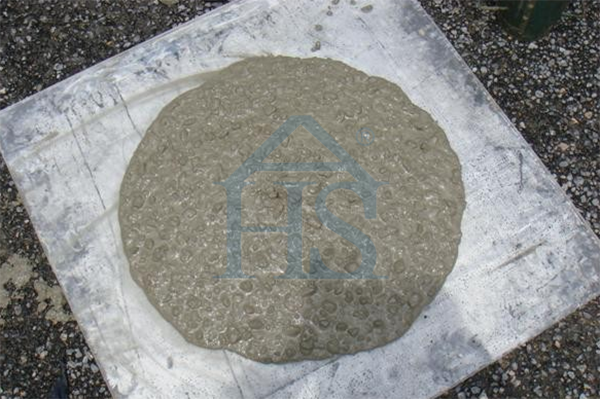Slakkenpoeder is een fijnkorrelig bijproduct dat wordt geproduceerd tijdens de scheiding van metaal uit het erts in verschillende metallurgische processen bij hoge temperaturen, zoals smelten en raffineren. Het is samengesteld uit verschillende mineralen en verbindingen, en de specifieke samenstelling ervan hangt af van het soort erts dat wordt verwerkt en de gebruikte productiemethoden.
Soorten slakkenpoeder
Gemalen Gegranuleerde Hoogovenslak (GGBFS)
GGBFS is een bijproduct van het ijzerproductieproces in hoogovens. Het ontstaat wanneer gesmolten slak snel wordt afgekoeld met water, resulterend in een glazige, gegranuleerd materiaal. Wanneer vermalen tot een fijn poeder, het vertoont cementachtige eigenschappen en kan worden gebruikt als aanvullend cementachtig materiaal in beton.
Staalslakpoeder
Staalslakpoeder is een bijproduct van het staalproductieproces. Het wordt gevormd tijdens de omzetting van ijzer in staal in een basiszuurstofoven of een vlamboogoven. Het is samengesteld uit verschillende oxiden en heeft potentiële toepassingen in de bouw- en landbouwsector.
Milieuvoordelen van slakkenpoeder
Het gebruik van slakpoeder is niet alleen economisch zinvol, maar biedt ook aanzienlijke voordelen voor het milieu. Door het gebruik van slakpoeder als aanvullend materiaal in diverse toepassingen, we kunnen het verbruik van natuurlijke hulpbronnen verminderen en de CO2-uitstoot verminderen. Aanvullend, Het gebruik van slakpoeder helpt bij het afvalbeheer door de hoeveelheid slak te verminderen die op stortplaatsen moet worden gestort.
Toepassingen van slakkenpoeder
Betonproductie
Slakkenpoeder wordt vaak gebruikt als aanvullend cementachtig materiaal bij de productie van beton, het vergroten van zijn kracht, duurzaamheid, en algemene prestaties. Het kan een portie portlandcement vervangen, het verminderen van de CO2-uitstoot en het verlagen van de totale kosten van de betonproductie.
Stabilisatie van de bodem
Slakkenpoeder kan worden gebruikt als bodemstabilisator, het verbeteren van de sterkte en stabiliteit van zwakke bodems. Het kan het risico op aardverschuivingen helpen verminderen, bodemerosie voorkomen, en het bevorderen van de vegetatiegroei in gebieden met slechte bodemgesteldheid.
Landbouw
Slakkenpoeder kan als bodemverbeteraar op landbouwvelden worden toegepast, het verbeteren van de bodemstructuur, beschikbaarheid van voedingsstoffen, en waterretentie. Het kan ook helpen zure grond te neutraliseren en de plantengroei te bevorderen, uiteindelijk de oogstopbrengsten verhogen.
Afvalbeheer
Slakkenpoeder kan worden gebruikt bij de behandeling en stabilisatie van gevaarlijk afval. Het kan zware metalen en andere verontreinigingen immobiliseren, voorkomen dat ze in het milieu terechtkomen en de risico's die gepaard gaan met afvalverwijdering verminderen.
Productieproces van slakkenpoeder
De productie van slakpoeder omvat doorgaans de volgende stappen:
- Verzameling van slakken uit industriële processen.
- Snelle afkoeling van gesmolten slak tot een glasachtige laag, gegranuleerd materiaal.
- Drogen en vermalen van de gegranuleerde slak tot een fijn poeder.
- Kwaliteitscontrolemaatregelen om ervoor te zorgen dat het eindproduct voldoet aan de vereiste specificaties voor de beoogde toepassing.
Eigenschappen en voordelen van slakkenpoeder
Slakkenpoeder biedt verschillende voordelen ten opzichte van traditionele materialen, inbegrepen:
- Verbeterde sterkte en duurzaamheid in betontoepassingen.
- Verbeterde weerstand tegen chemische aantasting en verminderde doorlaatbaarheid in beton.
- Lagere hydratatiewarmte, waardoor het risico op thermische scheurvorming in grote betonconstructies wordt verminderd.
- Het vermogen om zure bodems te neutraliseren en de bodemstructuur in landbouwtoepassingen te verbeteren.
- Afvalbeheer profiteert van de immobilisatie van zware metalen en andere verontreinigende stoffen.
Silicadamp versus slakkenpoeder
Silica rook en slakpoeder zijn beide materialen die vaak worden gebruikt als additieven in beton- en bouwtoepassingen.
Silica rook, ook wel microsilica genoemd, is een bijproduct van de productie van siliciummetaal en ferrosiliciumlegeringen. Het is een zeer fijn poeder met een hoog silicagehalte, doorgaans voorbij 90%. Wanneer toegevoegd aan beton, het verbetert de sterkte, duurzaamheid, en verwerkbaarheid van het mengsel.
Slakken poeder, anderzijds, is een bijproduct van de staalindustrie. Het ontstaat bij gesmolten slak, een afvalproduct van de staalproductie, wordt snel afgekoeld en vermalen tot een fijn poeder. Slakkenpoeder bestaat voornamelijk uit siliciumdioxide, calcium oxide, en aluminiumoxide. Wanneer toegevoegd aan beton, het kan de verwerkbaarheid verbeteren, kracht, en duurzaamheid van het mengsel.
Algemeen, het belangrijkste verschil tussen silicadamp en slakkenpoeder is hun oorsprong en chemische samenstelling. Silicadamp is een bijproduct van de siliciummetaalindustrie, terwijl slakpoeder een bijproduct is van de staalindustrie. Silicadamp heeft een hoger silicagehalte, terwijl slakpoeder een mix van verschillende oxiden bevat. Beide materialen kunnen worden gebruikt om de eigenschappen van beton te verbeteren, maar hun specifieke effecten kunnen verschillen afhankelijk van de toepassing.
Conclusie
Slakkenpoeder is een waardevolle hulpbron die tal van voordelen biedt in verschillende industrieën, van de bouw tot de landbouw en het afvalbeheer. Door slakpoeder te omarmen als duurzaam en veelzijdig materiaal, kunnen we onze impact op het milieu verminderen, behoud van natuurlijke hulpbronnen, en een groenere toekomst bevorderen.





